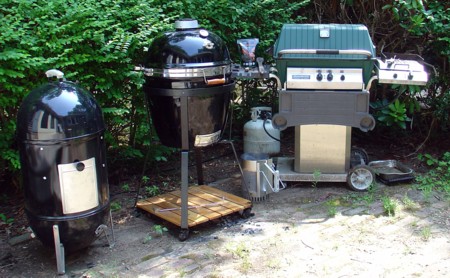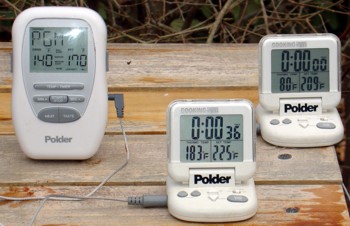Story and Photos by Mike Stines, Ph.B.

Recipes
All-Purpose Rub
Poultry Rub
Brisket Rub
Colleen’s Supreme Sauce
For those who love the taste of smoked foods but don’t like the expensive retail price in supermarkets and gourmet shops, there is an option. Smoke your own! Hot smoking, although time-consuming, is easily done and you don’t need to have one of those fancy $10,000 offset monsters shown on the cooking shows. Smoke-cooking most foods can be done in a kettle-style grill, a vertical smoker, a gas-fired grill, or even on your stovetop.
Smoking with a Charcoal Grill
Even though it can be done on a grill, remember that smoking is not the same as grilling. Smoking food takes a long time at a low temperature–usually around 225 degrees F., but grilling needs to be done quickly at a high temperature. If you have a traditional charcoal grill, such as the ever-popular Weber One-Touch (the 18 1/2-inch and 22 1/2-inch models range from about $100 to $180), you can smoke food by banking the charcoal on both sides of the kettle and cooking the food indirectly. To produce smoke, add to the coals some wood chips that have been soaked and drained. Place the meat, seafood or vegetables in the center of the cooking grate above the drip pan.
Using a charcoal grill requires some practice and a lot of patience. First you need to get the charcoal burning. The easiest way to do this is with a charcoal chimney, a large cylindrical device with a handle that allows you to pour the hot coals into the grill. Using a chimney is simple: fill the chimney with hardwood charcoal, place a couple of sheets of crumbled up newspaper under the bottom of the chimney and light the paper. In about 15 minutes, the coals will be ready.
A couple of hints about charcoal: use only natural charcoal, charcoal that doesn’t have additives and never use “self-lighting” charcoal. That’s charcoal that’s been impregnated with petroleum products to make them easier to light. Self-lighting charcoal often imparts an off-taste to food, especially when smoking “low and slow.” The same holds true for lighter fluid. It will give food a strange taste that isn’t particularly pleasant.
Another aspect of charcoal grill smoking is learning to regulate the grill’s temperature. Most charcoal grills have two sets of vents, one on the top of the grill and another on the bottom. The bottom vents control the heat of the fire (the wider the vents are open, the hotter the fire) while the top vents control the amount of smoke that stays in the cooking chamber, the wider the top vents are open, the less smoke remaining in the cooking chamber.
Remote Thermometers
And with any grill, gas or charcoal, the temperature needs to be monitored. The easiest way to check the grill’s temperature is to use a remote-reading thermometer placed on the cooking grate adjacent to whatever’s cooking. Polder makes a good unit that is popular with many backyard cooks. To monitor the grill temperature, simply insert the probe through a small potato or wine bottle cork and place it in the center of the cooking grate. Plug the cable into the thermometer unit and place the display outside the grill. Cover the grill and wait for the temperature to stabilize. Adjust the lower vents to regulate the temperature.
With a charcoal grill, the fuel and the wood chips need to be replenished on a regular basis. About an hour or so into the cook, start another chimney half-full of coals. When the coals are ash-covered, distribute them evenly over the burning coals. Add more drained chips, cover the grill and continue smoking. Try to replenish the fuel and wood quickly because the longer the cover is off of the grill, the cooler the grill will get, and the longer it will take to smoke-cook the food. (The higher-end Weber Gold models have a hinged cooking grate to make refueling easier.)top of article






